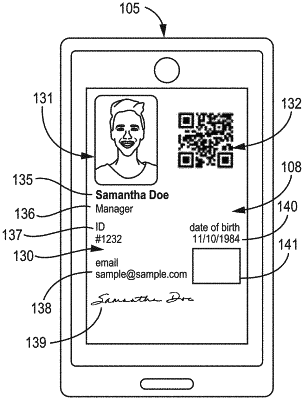| CPC B42D 25/305 (2014.10) [B42D 25/23 (2014.10); B42D 25/309 (2014.10); G06F 21/6245 (2013.01)] | 15 Claims |

|
1. A wearable electronic badge comprising:
an exterior surface that includes an attachment mechanism, the attachment mechanism configured to removably attach the wearable electronic badge to a wearer of the wearable electronic badge;
an antimicrobial coating at the exterior surface at least opposite the attachment mechanism;
a processor;
a wireless receiver connected to the processor, wherein the wireless receiver is configured to receive a programming signal from a remote user device, and wherein the programming signal includes a specified graphic that includes both a photo of the wearer of the wearable electronic badge and a text-based message;
a privacy button connected to the processor;
a microphone connected to the processor;
a location tracking mechanism connected to the processor, the location tracking mechanism configured to identify a current location of the wearable electronic badge;
a graphical display connected to the processor; and
a memory component connected to the processor,
wherein the memory component stores non-transitory computer-executable instructions that, when executed by the processor, cause the processor to display, at the graphical display, the photo of the wearer and the text-based message received via the programming signal from the remote user device as well as a quick-response code, the quick-response code being a unique code corresponding to the wearer of the wearable electronic badge,
wherein the privacy button is configured to selectively enable and disable display of predetermined information from the memory component, related to the wearer, at the graphical display while maintaining display of the quick-response code at the graphical display,
wherein the microphone is configured to detect ambient audio in the vicinity of the wearable electronic badge, wherein the non-transitory computer-executable instructions stored at the memory component include a voice recognition application that is configured, when executed by the processor, to cause the processor to compare the ambient audio in the vicinity of the wearable electronic badge to a plurality of audio records stored in the memory component to determine whether the ambient audio in the vicinity of the wearable electronic badge matches any one of the plurality of audio records stored in the memory component to a predetermined degree, wherein, when the processor determines that the ambient audio in the vicinity of the wearable electronic badge matches one of the plurality of audio records stored in the memory component to a predetermined degree, the processor is configured to cause the graphical display to display an indication of a source of the ambient audio in the vicinity of the wearable electronic badge, and
wherein the processor uses the current location of the wearable electronic badge as input from the location tracking mechanism to output a command to the privacy button to selectively enable and disable display of the predetermined information from the memory component based on the current location of the wearable electronic badge.
|